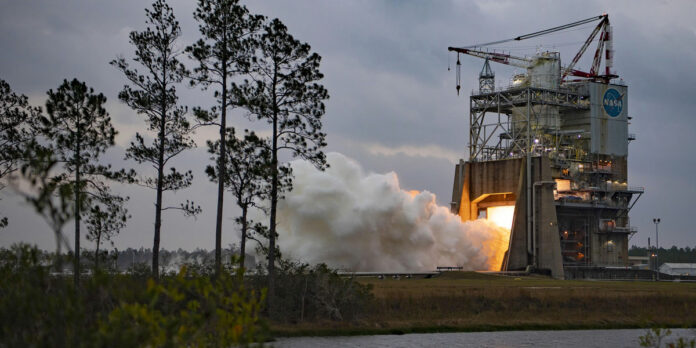BAY ST. LOUIS, Miss. — The first test of a redesigned engine for the Space Launch System was considered nominal by the Marshall Space Flight Center program’s manager.
NASA conducted the test this week at the Stennis Space Center near Bay St. Louis, Miss.
The hot fire test of the RS-25 was shut down 209.5 seconds into the scheduled 500-second hot fire. A non-flight system used to monitor the engine cut the engine. NASA and SLS lead engine contractor Aerojet Rocketdyne are analyzing data to review the monitoring system, evaluate engine performance, and identify the reason for the early test cutoff.
Because the test was for redesigned engines in support of Artemis V and beyond, no impact o is expected on the RS-25 hardware for earlier missions.
“Much like launch, test campaigns are dynamic events that allow us to learn more about the SLS rocket hardware,” said Johnny Heflin, liquid engines manager for the Space Launch System at the Marshall Space Flight Center. “NASA and Aerojet Rocketdyne teams were successful in running the first test of the new RS-25 restart engine for 209.5 seconds that will help power future missions with the SLS rocket.
“Preliminary data indicates the engine was performing nominally. Data analysis is underway.”
The single-engine hot fire, known as a confidence test, was designed to confirm all is ready to proceed with a series of certification tests early next year on a full RS-25 certification engine. NASA and Aerojet Rocketdyne modified 16 of the engines remaining after the Space Shuttle program for use on Artemis mission I through IV.
The upcoming series of testing is for the RS-25 engines that will be used beginning with Artemis V.
“Each test, even one that does not go full duration, helps us gather valuable data and helps us prepare to fly safely,” said Chip Ellis, Stennis RS-25 project manager.
For each SLS flight, four RS-25 engines, along with a pair of solid rocket boosters and core stage, help power the rocket at liftoff. The RS-25 engines fire simultaneously to generate a combined 1.6 million pounds of thrust at launch and 2 million pounds of thrust during ascent.
Every RS-25 engine that will help power SLS will be tested at Stennis. The tests are conducted by a combined team of NASA, Aerojet Rocketdyne and Syncom Space Services operators. Syncom is the prime contractor for Stennis facilities and operations.
Don’t miss out! Subscribe to our email newsletter to have all our smart stories delivered to your inbox.



